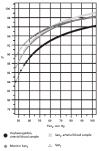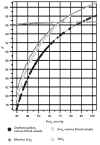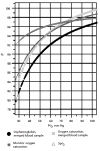Validation of oxygen saturation monitoring in neonates
- PMID: 17322018
- PMCID: PMC1931484
Validation of oxygen saturation monitoring in neonates
Abstract
Background: Pulse oximetry is commonly used to monitor oxygenation in neonates, but cannot detect variations in hemoglobin. Venous and arterial oxygen saturations are rarely monitored. Few data are available to validate measurements of oxygen saturation in neonates (venous, arterial, or pulse oximetric). Purpose To validate oxygen saturation displayed on clinical monitors against analyses (with correction for fetal hemoglobin) of blood samples from neonates and to present the oxyhemoglobin dissociation curve for neonates.
Method: Seventy-eight neonates, 25 to 38 weeks' gestational age, had 660 arterial and 111 venous blood samples collected for analysis.
Results: The mean difference between oxygen saturation and oxyhemoglobin level was 3% (SD 1.0) in arterial blood and 3% (SD 1.1) in venous blood. The mean difference between arterial oxygen saturation displayed on the monitor and oxyhemoglobin in arterial blood samples was 2% (SD 2.0); between venous oxygen saturation displayed on the monitor and oxyhemoglobin in venous blood samples it was 3% (SD 2.1) and between oxygen saturation as determined by pulse oximetry and oxyhemoglobin in arterial blood samples it was 2.5% (SD 3.1). At a Pao(2) of 50 to 75 mm Hg on the oxyhemoglobin dissociation curve, oxyhemoglobin in arterial blood samples was from 92% to 95%; oxygen saturation was from 95% to 98% in arterial blood samples, from 94% to 97% on the monitor, and from 95% to 97% according to pulse oximetry.
Conclusions: The safety limits for pulse oximeters are higher and narrower in neonates (95%-97%) than in adults, and clinical guidelines for neonates may require modification.
Figures



Comment in
-
Study's suggestion for oxygen saturation risks blinding neonates.Am J Crit Care. 2007 Sep;16(5):428-9; author reply 429. Am J Crit Care. 2007. PMID: 17724234 No abstract available.
Similar articles
-
Pulse Oximetry Overestimates Oxyhemoglobin in Neonates with Critical Congenital Heart Disease.Neonatology. 2016;109(3):213-8. doi: 10.1159/000442379. Epub 2016 Jan 23. Neonatology. 2016. PMID: 26800085
-
Use of pulse oximetry to monitor venous saturation during extracorporeal life support.Crit Care Med. 1994 Apr;22(4):626-32. doi: 10.1097/00003246-199404000-00019. Crit Care Med. 1994. PMID: 8143472
-
Oxygen consumption monitoring by oxygen saturation measurements in mechanically ventilated premature neonates.J Perinat Neonatal Nurs. 2006 Apr-Jun;20(2):178-89. doi: 10.1097/00005237-200604000-00013. J Perinat Neonatal Nurs. 2006. PMID: 16714919
-
Retinal oximetry and systemic arterial oxygen levels.Acta Ophthalmol. 2018 Nov;96 Suppl A113:1-44. doi: 10.1111/aos.13932. Acta Ophthalmol. 2018. PMID: 30460761 Review.
-
Advanced Uses of Pulse Oximetry for Monitoring Mechanically Ventilated Patients.Anesth Analg. 2017 Jan;124(1):62-71. doi: 10.1213/ANE.0000000000001283. Anesth Analg. 2017. PMID: 27183375 Review.
Cited by
-
A model-based decision support system for critiquing mechanical ventilation treatments.J Clin Monit Comput. 2012 Jun;26(3):207-15. doi: 10.1007/s10877-012-9362-0. Epub 2012 Apr 25. J Clin Monit Comput. 2012. PMID: 22532227
-
Feasibility Analysis of ECG-Based pH Estimation for Asphyxia Detection in Neonates.Sensors (Basel). 2024 May 24;24(11):3357. doi: 10.3390/s24113357. Sensors (Basel). 2024. PMID: 38894148 Free PMC article.
-
Monitoring Oxygenation and Gas Exchange in Neonatal Intensive Care Units: Current Practice in the Netherlands.Front Pediatr. 2015 Nov 3;3:94. doi: 10.3389/fped.2015.00094. eCollection 2015. Front Pediatr. 2015. PMID: 26579504 Free PMC article.
-
Pulse oximetry: fundamentals and technology update.Med Devices (Auckl). 2014 Jul 8;7:231-9. doi: 10.2147/MDER.S47319. eCollection 2014. Med Devices (Auckl). 2014. PMID: 25031547 Free PMC article. Review.
-
Fetal Hemoglobin and Tissue Oxygenation Measured With Near-Infrared Spectroscopy-A Systematic Qualitative Review.Front Pediatr. 2021 Aug 13;9:710465. doi: 10.3389/fped.2021.710465. eCollection 2021. Front Pediatr. 2021. PMID: 34485197 Free PMC article.
References
-
- Shiao SYPK. Functional versus fractional oxygen saturation readings: bias and agreement using simulated solutions and adult blood. Biol Res Nurs. 2002;3:210–221. - PubMed
-
- Bunn HF, Forget BG. Hemoglobin: Molecular, Genetic and Clinical Aspects. Philagdelphia, Pa: WB Saunders Co; 1986. Hemoglobin A2, F, and other human hemoglobin components; pp. 61–90.
-
- Wimberly PD. Oxygen monitoring in the newborn. Scand J Clin Lab Invest Suppl. 1993;214:127–130. - PubMed
-
- Wimberly PD, Siggaard-Anderson O, Fogh-Anderson N. Accurate measurement of hemoglobin oxygen saturation, and fraction of carboxyhemoglobin and methemoglobin in fetal blood using Radiometer OSM3: corrections for fetal hemoglobin fraction and pH. Scand J Clin Lab Invest Suppl. 1990;203:235–239. - PubMed
-
- Chulay M, Palmer J, Neblett J, Nancherla AR, Tripodi D, Caden D. Clinical comparison of two- and three-wavelength systems for continuous measurement of venous oxygen saturation. Am J Crit Care. 1992;1:69–75. - PubMed
Publication types
MeSH terms
Substances
Grants and funding
LinkOut - more resources
Full Text Sources
Medical
